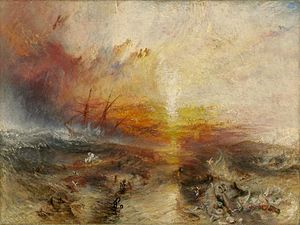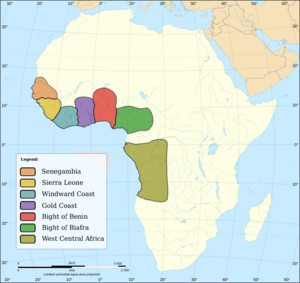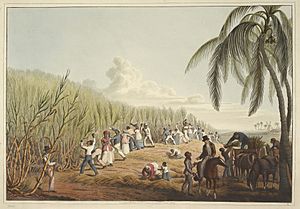George Case (slave trader) facts for kids
George Case (1747–1836) was a British man who made his fortune from the slave trade. He was involved in at least 109 voyages that transported enslaved people across the ocean. Case was also a co-owner of the slave ship Zong. The crew of this ship committed a terrible act known as the Zong massacre. After this event, the ship owners tried to get insurance money for the enslaved people who were killed. This caused a huge public outcry and helped to strengthen the movement to end slavery in the United Kingdom. In 1781, George Case became the Mayor of Liverpool. After he died, the money he earned from the slave trade was later used to create the Case Fund by his grandson.
Contents
The Slave Trade
George Case was one of the most active slave traders in Britain. His slave ships usually followed a route called the triangular transatlantic slave trade.
- The first part of the journey involved ships taking goods from Britain to Africa. These goods were then traded for enslaved people.
- Next, the enslaved people were forced onto ships and taken across the Atlantic Ocean to the Americas or the Caribbean. This was a brutal journey known as the Middle Passage.
- Finally, the ships returned to Britain carrying goods like sugar and cotton, which were produced by enslaved labor.
Case was responsible for at least 109 slave voyages. More than 40% of the enslaved people he transported were taken from the Bight of Biafra, an area in the Gulf of Guinea today. Over 40% of these people were delivered to Jamaica in the Caribbean, which was a British Colony at the time. Many of the enslaved people were forced to work on plantations growing sugar or cotton. Others were forced into domestic service in homes.
In 1780, Case joined a group of other slave traders. They sent a ship called the William on five slave voyages. In 1798, Case sent another ship, the Molly, to Angola. There, its captain purchased 436 enslaved people.
Life for Enslaved People
Just under half of the enslaved people Case sold ended up in Jamaica. They were treated terribly after being sold. Enslaved people were forced to work long hours in harsh conditions. They had no freedom and were often subjected to violence. Their lives were extremely difficult and filled with suffering.
The Zong Massacre
George Case was a co-owner of the slave ship Zong, along with another man named William Gregson. During a voyage, the ship started to run low on drinking water. The crew then committed a horrific act: they murdered 142 enslaved people by throwing them into the sea.
After this, the ship owners tried to claim insurance money for the people they had killed. The insurance company refused to pay. The court case that followed brought these terrible murders to the attention of many people.
In the first court ruling, the judge, Lord Mansfield, sided with the slave traders. He even said that the "Case of Slaves was the same as if Horses had been thrown overboard." This outcome caused a huge public outcry. It greatly strengthened the movement to end slavery in the UK.
Case and Gregson demanded £30 for each enslaved person they claimed was "lost." Abolitionists like Olaudah Equiano and Granville Sharp started a campaign. They pushed for legal action against everyone involved in throwing the 133 enslaved people into the sea. While the court cases did not stop slave traders from harming their victims, they became a major event. They helped to turn public opinion strongly against slavery.
The Slave Ship Painting

The Zong massacre is believed to have inspired a famous painting called The Slave Ship. It was painted in 1840 by J. M. W. Turner. Turner was a well-known English painter of landscapes and also supported the movement to end slavery. The painting shows a slave ship in a storm. You can see dark-skinned people in chains in the water. This powerful painting is now owned by and displayed at the Museum of Fine Arts in Boston, USA.
Mayor of Liverpool
In 1781-1782, George Case served as the Mayor of Liverpool. Liverpool was the most important city in Britain for the slave trade at that time. At least twenty-five Mayors of Liverpool were involved in the slave trade.
In 1787, the Liverpool Council became worried about the growing movement to end slavery. They asked Parliament not to make rules about the slave trade. In 1788, the Liverpool Council told Parliament that the slave trade had been carried out legally for centuries. They claimed it brought "important and extensive" benefits to the country. However, they admitted it had recently been called "unjust and inhuman."
A portrait of Case, painted by Thomas Phillips, is part of the collection at the Walker Art Gallery in Liverpool. The painting shows Case wearing his robes as mayor.
The Case Fund
George Case's wealth was passed down through his family. In 1898, his grandson, also named George Case, left this money to the Hibbert Trust. The Hibbert Trust now calls this money the Case Fund. The fund aims to support "liberal religion" and encourages people to think freely about religious matters.
In 2020, because of the Black Lives Matter movement, the trust started an investigation. They wanted to decide how to use the fund given its history. The trust stated that in 2020, less than half of the Case Fund's money came from Case's involvement in slavery. They said it was hard to give a more exact number. The trust also wrote, "The Trustees acknowledge that people of colour have been victimised by white privilege for over 400 years." They promised to find ways to make things right.




